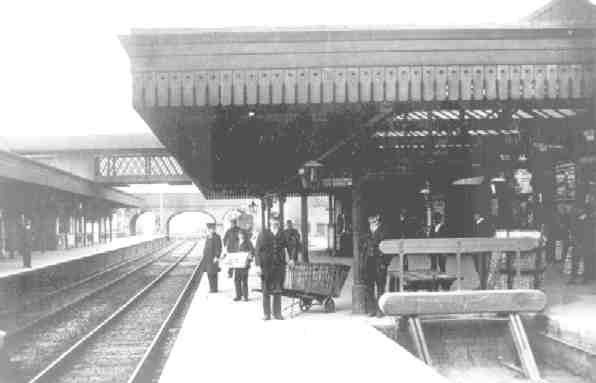
The national railway network incorporated Huntingdonshire during the mid-19th century. In 1850 the Great Northern line, passing from north to south of the county, was opened. To cross the Fwenland took a major feat of engineering the embankments being constructed of alternate layers of peat and faggots to force out the water.
This was not the earliest line. Before 1845 a track had been constructed to run between Peterborough and Blisworth, passing through Stibbington and the two Ortons. Another branch line appeared in the 1860's running between Huntingdon and Kettering with stations at Buckden, Grafham and Kimbolton.
A line between Godmanchester and St. Ives was built in 1847 designed to link up to the already existing St. Ives to Cambridge line. Unfortunately the connection between Huntingdon staion and Godmanchester was not constructed until 1875. Before that date passengers had to travel by coach or carrier between the two stations. In 1848 a branch line was opened between St. Ives and Wisbech with a station at Somersham. Further branch lines opened between Holme and Ramsey (1864), St. Ives and Ely (1878) and Ramsey and Somersham (1889).
The coming of railways was not necessarily a good proposition for Huntingdon as it was a coaching centre, like a few other places, within the county. The railways rendered long-distance coach travel uneconomic. The railways also caused a decline in the bustling river trade on the Ouse, especially the transportation of coal. It was not all bad news as other industries began to emerge because f the railways; fruit growing grew, farming improved as milk and butter wre sent to London, livestock farmers sent their cattle by train it being a quicker method than driving them and they arrived in a better condition.
The railways were crucial in developming the brick-making industry dur to the facilities provided for long distance transportation. Although the brick industry had become firmly established by the 19th centur, the arrival of the railways gave a boost to the fortunes of the industry. The first brick-works opened at Fletton in 1879 the increase in population being dramatic, in 1831 there had been under two hundred inhabitants, by 1881 there were almost two thousand. A brick-works opened in 1886 in Huntingdon but found it could not compete with the works at Fletton and subsequently closed but at Warboys a works opened in 1895 and is still in operation.
As well as benefits the railways also brought danger. On 22 January 1876 Abbots Ripton was the scene of a famous rail disaster. A coal train being shunted into sidings was hit by the Scottish express, which was itself in collision with the London train coming the other way. Fifteen people were killed, and Huntingdon was in mourning for the following four days. This disaster led to radical changes in signalling methods throughout the United Kingdom rail network. (15 people does not sound many but in proportion to the population of the time it was a large number.)
With the advent of the motor car a decline in the railways was seen. The roads were built along many of the old horse-drawn 19th-century coaching routes. The only surving line is the old Great Northern line between London and York. All the branch lines were closed between 1958 and 1970, except for the Peterborough to Wansford stretch. The new road network saved the old coaching inns from oblivion into which they were falling brining new customers and prosperity.
The source of this information is "A History of Huntingdonshire" by Michael Wickes
ISBN 0 85033 953 7 Published byPhilimore & Co. Ltd.